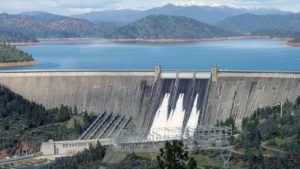California’s Dry Winter Leads Reclamation to Conservative Initial Water Allocation
The Bureau of Reclamation this week announced the initial 2018 water supply allocation for many Central Valley Project contractors. This allocation is based on a conservative estimate of the amount of water that will be available for delivery to CVP water users and reflects current reservoir storages, precipitation and snowpack in the Central Valley and the Sierra Nevada.
The 2017 water year was the wettest on record for most of northern California and CVP reservoirs were essentially full for the first time in five years; however, precipitation so far this year has been far below average. The California Department of Water Resources (DWR) reports that as of Feb. 15, the statewide average snow water equivalent in the Sierra Nevada was 4.3 inches (20% of the historical average), and rainfall is currently at approximately 60% of the historical average for the northern Central Valley.

Shasta Dam, across the Sacramento River in Northern California, creates the state’s largest reservoir, Shasta Lake. Water managers are uncertain about managing it in a way to provide protection for endangered salmon.
“Despite the historic rainfall last year, California’s lack of sufficient water storage forces us to operate on a year-to-year basis. The amount we can store in our reservoirs is not enough to get us through these very dry years,” says David Murillo, Reclamation’s Mid-Pacific Regional Director. “Given what we know today, and what we see in the forecast, we must be very conservative with our allocation. If this lack of rain and snow continues, we could very well be right back in drought operations. A situation like this really underscores the need for more storage in California.”
“There are many factors we have to consider when determining CVP allocations — hydrologic conditions, reservoir storage levels, water quality requirements, water rights priority, contractual obligations, and endangered species protections,” Murillo said. “All of these are taken into account with the goal of exercising all authorities available to us to maximize water supplies.”
Given storage of CVP water in San Luis, Millerton, and New Melones Reservoirs, as well as conservative assumptions regarding Delta operations over the next couple of months, Reclamation is able to provide an initial allocation to South-of-Delta, Friant, and Eastside contractors of the CVP. Regarding the remainder of the allocations to CVP contractors, although the CVP is operationally integrated, each individual reservoir has unique and specific operational criteria that must also be met.
Due to the extremely low snowpack levels and associated runoff forecasts, combined with the uncertainty in the ability to manage Shasta Reservoir in a way that will provide adequate temperatures for the protection of endangered salmon species in the Sacramento River throughout the summer and fall in 2018, Reclamation will not be providing an initial allocation of water to North-of-Delta Contractors at this time. The integrated nature of the operation of Shasta and Folsom Reservoirs requires the same approach for American River and In-Delta Contractors.
Reclamation will be working with these contractors, as well as the National Marine Fisheries Service (NMFS), during the next week to ensure that water will continue to be delivered to meet public health and safety needs for municipal and industrial contractors and appropriate minimal needs of agricultural contractors during the month of March. This approach will allow Reclamation, NMFS, and the contractors to refine operating scenarios based on updated snowpack and runoff forecasts in March, and develop appropriate plans for dealing with the extremely dry conditions should they continue.
Should conditions change, CVP supplies could also change. Reclamation will continue working with the DWR, federal and state fishery agencies, our contractors, and others to effectively carry out project operations and improve water supply consistent with all applicable laws. Based on the information outlined above, Reclamation is announcing the initial allocation to the following:
South-of-Delta Contractors
- Agricultural water service contractors South-of-Delta are allocated 20 percent of their contract total.
- Municipal and industrial water service contractors South-of-Delta are allocated the greater of 70 percent of their historic use or public health and safety needs.
Friant Division Contractors
- Based upon Millerton Lake storage and current and forecasted hydrologic conditions in the Upper San Joaquin River Basin, the Friant Division contractors are allocated 30 percent of Class 1 supplies.
- For the San Joaquin River Restoration Project, the current best forecast developed jointly by SJRRP and the South-Central California Area Office now indicates a “Critical-High” water year type.
Eastside Water Service Contractors
- Eastside water service contractors (Central San Joaquin Water Conservation District and Stockton East Water District) will receive 100 percent of their contract total.
On Feb. 15, Reclamation notified the Sacramento River Settlement Contractors, San Joaquin River Exchange Contractors, San Joaquin Settlement Contractors, and Refuge Contractors that the forecasted inflow to Shasta Lake is currently greater than 3.2 million acre-feet and we are not currently in a “Shasta Critical” year as that term is defined in their contracts.
Current dry conditions and the dry forecast underscore the need for all Californians to be conservative in their water use this spring, Murillo said. Without significant rain and snow this spring, conditions could worsen.
As the water year progresses, changes in hydrology and opportunities to deliver additional water will influence future allocations. Water supply updates will be made as appropriate and posted.









